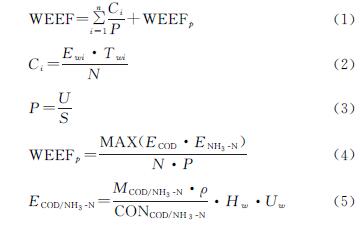1.2.1 基于能值理论的水资源生态足迹模型
(1)水资源能值生态足迹(WEEF)。生态足迹代表了人类负荷强度,反映了区域生态和经济特征。根据传统水资源生态足迹和能值生态足迹模型,建立WEEF模型。利用太阳能值转换率,根据不同种类用水量得到水资源人均太阳能值,再通过区域水资源能值密度得到消耗水资源的生物生产性土地面积,即为WEEF。此外,水资源作为一种供给人类发展需求的资源,还承担着消纳人类产生废弃物的作用。因此WEEF由用水足迹和污染足迹组成,其中用水足迹包括农业用水、工业用水、生活用水、生态用水等用水足迹,污染足迹为消纳污染的足迹。其计算方法为[18]:

式中:WEEF为人均水资源能值生态足迹(hm2/人); Ci为第i种用水的人均太阳能值(sej/人); Ewi为第i种用水量(m3); Twi为第i种用水的太阳能值转换率(sej/m3); N为人口总数; P为区域能值密度(sej/hm2); U为区域能值总量(sej); S为研究区域面积(hm2); WEEFp为人均水资源污染足迹(hm2/人); ECOD和ENH3-N分别为化学需氧量(COD)和氨氮的能值(sej); MCOD/NH3-N为COD或氨氮的废水排放量(t); ρ为水的密度(1 000 kg/m3); CONCOD/NH3-N为COD或氨氮的允许排放浓度,可在《北京市水污染物排放标准》(DB11/307-2005)中获得; COD为30 mg/L,氨氮为1.5 mg/L; Hw为热值系数(2.56E+04 J/kg); Uw为水的单位能值,由集水区年降水总能值与年集水化学相除的多年平均值得到,取值为3.02 E+04 sej/J。具体计算方法为[19]:

雨水化学能=区域面积×年降水量×蒸散系数(60%)×水密度×雨水吉布斯自由能(7)
地表水(地下水)化学能=水量×地表水(地下水)吉布斯自由能×水密度(8)
其中,雨水的太能能值转换率参考《能值评估手册》,取值为1.54E+04 sej/J[13]。吉布斯自由能是指各类水体相对于海水的吉布斯自由能,计算公式为:

式中:s为水体的固体物质溶解量(mg/kg)。雨水、地表水、地下水的固体物质溶解量分别为10 mg/kg,56.9 mg/kg,300 mg/kg。
(2)水资源能值生态承载力(WEEC)。水资源生态承载力是区域水资源丰富程度的度量。北京市水资源主要来源于地表水、地下水和雨水。能值理论中雨水能值分为雨水化学能和雨水势能,雨水化学能降落到地表后,随地表径流会转化为地表水化学能,随土壤渗透至地下水后会转化为地下水化学能,因此北京市水资源能值组成为地表水化学能、地下水化学能和雨水势能(图1)。此外有研究表明[20],区域对水资源开发利用率若超过40%将会引起该区域生态环境恶化,因此在计算水资源生态承载力时要乘以0.4作为开发水资源的利用率。其计算模型为:

式中:WEEC为人均水资源能值生态承载力(hm2/人); EG为地表水化学能(sej); EU为地下水化学能(sej); ER为雨水势能(sej); Pw为区域水资源平均能值密度(sej/hm2)。
(3)相关参数的确定。区域能值密度P和区域水资源能值密度Pw是根据北京市区域能值和水资源能值除以北京市面积的多年平均值得出,区域能值密度为1.35E+15 sej/hm2,区域水资源能值密度为5.85E+14 sej/hm2。各种用水或水资源的能值通过将用水量乘以相应能值转化系数来计算。表1是本文用到的能值转化系数及其来源,其中雨水势能计算方法为[16]:
ER=S×Rain×Runoff×ρ×elevation×g(11)
式中:S为区域面积(m3); Rain为平均降水量(m); Runoff为径流系数(0.4); elevation为平均高程(m); g为重力加速度(9.8 m/s2)。
1.2.2 水资源生态足迹评价指标
(1)水资源生态赤字/生态盈余(WED/WES)。WED/WES能直接反映区域对水资源的利用强度。当WEEC>WEEF时为生态盈余(WES),区域水资源供给满足人类需求; 反之,区域水资源供给则不能满足人类需求,区域社会经济发展对当地水资源生态安全构成威胁; WEEC=WEEF时水资源生态平衡。其计算公式如下[2]:
WED(WES)=WEEC-WEEF(12)
(2)水资源生态压力指数(WEFI)。WEFI利用水资源生态系统单位生态容量承受的压力来评价水资源生态安全。根据Yang等[16]对区域生态安全等级划分的研究结果,当WEFI<1时,人类消耗小于生态承载,表明水资源处于生态安全状态; WEFI>1时,生态系统承受压力大于实际生态承载力,说明水资源生态不安全; WEFI=1时则表明区域水资源供需处于平衡状态(表2)。与WED/WES相比,WEFI为无量纲,可用于不同区域间水资源利用情况的比较。其计算公式为:
WEFI=WEEF/WEEC(13)
生态安全等级 生态安全状态 生态压力范围1 安全 0~12 亚安全 1~103 轻度不安全 10~184 中度不安全 18~245 高度不安全 24~306 极度不安全 ≥30
(3)水资源生态经济协调指数(WEECI)。WEECI可反映生态环境与社会经济之间的生态协调性,区域社会经济发展是否在生态环境承载范围内以及能值生态足迹与区域资源禀赋之间的关系。本文引进该指数来评价水资源生态系统与社会经济之间的协调性以及区域社会经济发展与水资源禀赋之间的关系。其计算方法为[15]:

其中,WEECI取值区间为(1,1.414)。WEECI越接近1,则生态协调性越差; WEECI越接近1.414,则说明生态协调性越好; 当WEECI=1.414时,处于最佳生态协调状态。
1.2.3 格网水资源生态足迹 水资源生态足迹计算受限于统计数据的缺失。统计数据多数以行政区域(市、区等)为统计单元,更小单元的统计数据基本缺失或难于获得。鉴于GIS数据可提供不同格网单元的人口、降水量等空间分布数据,因此本文利用ArcGIS软件的数学分析方法,将北京市WEEF,WEEC,WED,WEFI,WEECI进行1 km尺度格网化,并与北京市区划矢量数据叠加,获得格网和区域尺度相关数据[25]。
WEEFij=(WEEFi)/(pi)×pj+Pl(15)
式中:WEEFij为第i个行政区第j个格网的水资源能值生态足迹; WEEFi为第i个行政区的用水能值生态足迹; pi为第i个行政区的人口数量; pj为第j个格网内的人口数量。
在水资源生态承载力的计算中,由于北京城市化现象十分明显,自来水供水情况已非常普遍,因此本文假设同一行政区内,人均水资源供给水平一致,结合1 km格网降水量空间分布数据,可计算各格网内的雨水势能,三者相加得到格网水资源能值生态承载力,具体计算公式为:
WEECij=(WEECGi+WEECUi)×pj+WEECRj(16)
式中:WEECij为第i个行政区第j个格网的水资源生态承载力; WEECGi和WEECUi分别为为第i个行政区的人均地表水生态承载力和人均地下水生态承载力; WEECRj为第j个格网的雨水势能包含的水资源生态承载力。
在水资源生态足迹评价指标的计算中,WED,WEFI,WEECI均可由格网水资源生态足迹与格网水资源生态承载力按照1.2.2节中式(12-14)进行计算。
1.2.4 传统水资源生态足迹 为分析水资源能值生态足迹与传统水资源生态足迹的差异及其产生原因,本文根据文献[3]提出的传统水资源生态足迹方法[3],文献[26]提出的水污染足迹计算模型[26],计算北京市2005—2018年的水资源生态足迹。其中,均衡因子取世界自然基金会在2002年的测算结果5.19,产量因子根据北京市多年产水模数与世界平均产水模数的比值计算得出为0.54,世界水资源平均生产能力为3 140 m3/hm2,水消纳COD全球平均生产能力为0.094 2 t/hm2,水消纳氨氮全球平均生产能力为0.004 71 t/hm2。